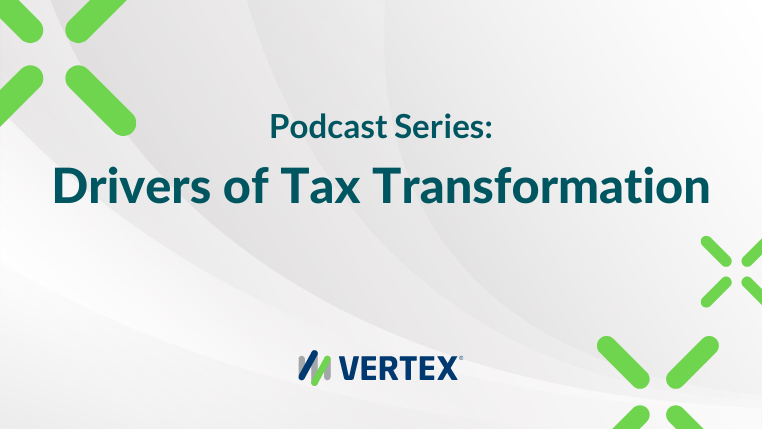Steve Johnston: Welcome to Tax Matters, a Vertex podcast! I’m Steve Johnston, Product Marketing Manager at Vertex.
Let’s say your tax function is ready to take its transformation journey to the next level. How do you proceed? What technology options should you evaluate? And what types of functionalities should a “next-generation” tax automation solution offer?
IDC Research Director for Financial Applications, Kevin Permenter, discusses all of that and more with Business Writer, Eric Krell, in this episode of our series on tax transformation,
Kevin runs through the build vs. buy decision and the advantages of a “cloud-first” approach. He devotes the rest of this episode to a detailed assessment of the features tax technology buyers should look for in a solution.
Now, I’ll turn it over to moderator, Eric Krell, and Kevin Permenter…
Eric: Kevin, you’ve shared some great insights on the factors driving the need for tax transformation. I want to ask you about the approaches that businesses are taking. What are their options and what are some factors they should consider when determining which tax-transformation approach is the best fit for them?
Kevin: There are three main categories. They can outsource it to one of the accounting firms out there. That’s something that we see a lot in the direct tax world. Next, what we need to know is: should we build our own software, or buy software? There are a number of ways get it all done. The one way I see the most – the way that has the most scalability and flexibility -- is going through and actually buying or subscribing to software with some of these cloud software providers.
Eric: So, a tax group is ready to invest in new automation: What functionalities and capabilities should they be aware of? Tell me three qualities they should look for in a solution?
Kevin: Right off the top of my head, I’m thinking cloud, cloud, and cloud. But I’ll give you more than that. But definitely: cloud-first. They should be looking for a software that’s built in the cloud, that has cloud-native principles – [a vendor] that’s developing their platform to meet tomorrow’s demand through the use of microservices, containerisation, and those sorts of things. That’s what they should be looking for on the cloud side, I think security is incredibly huge, so you’re going to be looking for organisations that have as many certifications as humanly possible. And then [third], scalability, flexibility, I put those in the same category. The idea is that the world around the tax department is constantly shifting, so they need software that allows for low-code, no-code configurations and changes that don’t put a ton of pressure -- either on the line-of-business person or on the IT team … that allow them to keep up with the pace of business.
Eric: OK, so cloud-first, data security, and scalability, and flexibility. What can you tell me about the automation functionality that they should be looking for?
Kevin: Yes, so automation is really going to be important. One of the things that you’re going to be looking for is all the places where there’s a ton of data demand. Think about calculation, filing, think about product classification, think about all of these areas that are data-intensive that may require someone scrolling through hundreds or even thousands of codes to get it right, or dealing with thousands of lines. These are places where RPA and AI-driven automation are really going to make a huge difference, not just to the accuracy of the output, but also to the employee experience. Who wants to sit there and thumb through a spreadsheet that has thousands of product codes to guess which one this pair of jeans fits in?
Eric: Is there anything else that buyers should look for in a tax solution?
Kevin: Yes, I would say it’s important to be able to get data into the software, but it’s equally important to get the data out of the software. So, analytics and reporting become hugely important. What’s happening with our taxability footprint, right? What happened last year? What happened last week? What’s going to happen next week? These are the kinds of questions that businesses run off of, and they need software that can handle those questions while providing tools to help the line of business folks inside of the tax department answer those questions at speed and at scale.
I would say also the ability to integrate; the integration is going to be increasingly important. We mentioned earlier, that the tax world, is really connected to a long value chain of financial activities. Because of that, it’s got to be able to share data back and forth with the CRM [system], the FP&A teams, external sources of data, of course, the tax authorities. It’s got to be able to share data with all these places, so its ability to integrate and be integrated with is incredibly important.
Eric: How important is it to have a single unified platform from a consistency and efficiency standpoint, Kevin?
Kevin: It’s going to be incredibly important. This idea actually emanates from the users. The idea is, "Hey, we’d like a single pane of glass through which we can see our entire financial footprint.” In this case, that view is for the tax office, [and it covers] the entire tax burden, or taxability, of the entire business. Having all of that information flow into one system, and then be immediately available to be looked at, viewed by various job roles, configured and reconfigured is going to be incredibly important. When you start talking about terms like agility, well, it can sound kind of fuzzy … But at its core, it’s basically about how much data about your business can you see at any particular time so that you can make data-driven decisions at speed. That’s why it’s important to have that single platform.
Eric: On that note, let me ask you one more question. When you look at the way tax technology is likely to evolve in the future, what do you find most interesting? What’s exciting you?
Kevin: The future is going to be digital. We know that. It’s going to be digital information, sometimes digital tax information about selling digital goods to digital entities … And it’s going to be intelligent. We know that tomorrow, the demands of the tax world in terms of regulations, data volume, in terms of its importance and strategic nature are necessitating that the systems that support it will be augmented with machine learning and artificial intelligence. We know that tomorrow’s software will be used to support intelligent processes, and because of that, we know that at its core, it’ll have to also be intelligent.
Eric: Kevin, it’s been incredibly informative and a pleasure talking with you today. Thank you.
Kevin: Thank you.
Steve Johnston: Thanks for listening to Tax Matters and our series on tax transformation.
This transcript has been edited for clarity.


